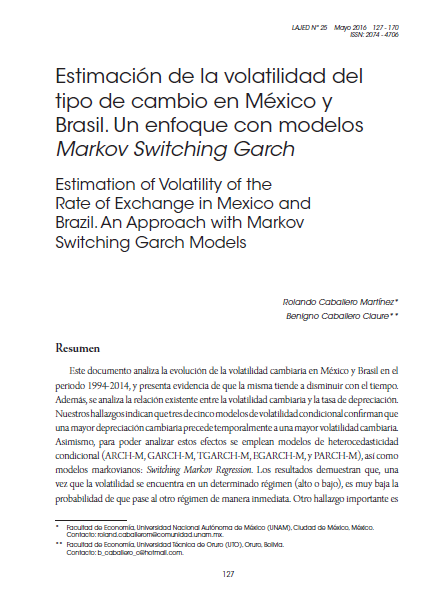Estimation of Volatility of the Rate of Exchange in Mexico and Brazil. An Approach with Markov Switching Garch Models
DOI:
https://doi.org/10.35319/lajed.20162565Keywords:
Stochastic Volatility, Financial Econometrics, EGARCH-MAbstract
This paper analyzes the evolution of exchange rate volatility in Mexico and Brasil in the period 1992:01-2013:12 and presents evidence that it tends to decrease over time. We also discuss the relationship between exchange rate volatility and depreciation. Our findings indicate that further depreciation change temporally precedes greater exchange rate volatility. Also to analyze these effects models conditional heteroskedasticity (ARCH-M, GARCH-M, TGARCH-M, EGARCH-M and PARCH-M) was used. The results of our study show that once the volatility is in a regime is very low probability of passing to another regime immediately. Another important finding is the high persistence in volatility in both economies, confirming that shocks it cannot dissipate quickly.
Downloads
References
Andersen, T.G. y T. Bollerslev. 1998. “DM-Dollar Volatility: Intraday Activity Patterns, Macroeconomic Announcements and Longer-Run Dependencies”, Journal of Finance, 53, 2190-265.
Awartani, B.M.A. y V. Corradi. 2005. “Predicting the volatility of the S&P-500 stock index via GARCH models: the role of asymmetries”, International Journal of Forecasting, 21, 167-183.
Banxico. 1993. Banco de México. Información económica.
Banxico. 2008. Banco de México. Información económica.
Benavides, G. y C. Capistrán. 2009. “Una nota sobre las volatilidades de la tasa de interés y del tipo de cambio según diferentes instrumentos de política monetaria: México, 1998-2008”. Banco de México, Documento de investigación, N° 2009-10.
Bollerslev, T. 1986. “Generalized Autoregressive Conditional Heteroskedasticity”, Journal of Econometrics, 31, 307-327.
Bollerslev, T., R. Y. Chou y K. F. Kroner. 1992. “ARCH modeling in finance: A review of the theory and empirical evidence”, Journal of econometrics, 52 (1-2), 5-59.
Bollerslev, T., R. F. Engle y D. B. Nelson. 1994. “ARCH models”. Handbook of econometrics, 4, 2959-3038.
Baqueiro, A., A. Díaz de León y A. Torres García. 2003. “¿Temor a la flotación o a la inflación? La importancia del ‘traspaso’ del tipo de cambio a los precios”. Banco de México, Documento de investigación, N° 02.
Brooks, C. 2002. Introductory econometrics for finance. Cambridge University Press.
Caballero, Benigno. 2003. “Notas de clase de econometría y estadística”, Universidad Técnica de Oruro.
De Gregorio, J., A. Tokman y R. Valdés. 2005. “Flexible exchange rate with inflation targeting in Chile: Experience and issues”, Inter-American Development Bank, Working Paper N°540.
Diebold, F.X., J.H. Lee y G.C. Weinbach. 1993. “Regime -Switching with time varying transition probabilities”. En: C. Hargreaves, Nonstationary Time Series and Cointegration. Oxford University Press.
Diebold, F. X. y R. S. Mariano. 1995. “Comparing Predictive Accuracy”, Journal of Business and Economic Statistics, 13, 253-263.
Ding, Z. y C. W. Granger. 1996. “Modeling volatility persistence of speculative returns: a new approach”, Journal of econometrics, 73 (1), 185-215.
Domowitz, I. y C. Hakkio. 1985. “Conditional Variance and the Risk Premium in the Foreign Exchange Market”, Journal of International Economics, vol. 19, 47-66.
Edwards, S. 2007. “fte relationship between exchange rates and inflation targeting revisited”. En: F. Mishkin y K. Schmidt-Hebbel (eds.), Monetary Policy under Inflation Targeting. Banco Central de Chile, Santiago de Chile.
Engel, C. y C. S. Hakkio. 1996. “The distribution of exchange rates in the EMS”, International Journal of Finance & Economics, 1 (1), 55-67.
Engle, R.F. 1982. “Autoregressive Conditional Heteroskedasticity with Estimates of Variance of U.K. Inflation”, Econometrica, 50, 987-1007.
Engle, R y T. Bollerslev. 1986. “Modelling the Persistence of Conditional Variance”,Econometric Review 5, 1-50 y 80-87.
Glosten, L.R., R. Jagannathan y D.E. Runkle. 1993. “On the relation between the expected value and the volatility of the nominal excess return on stocks”, Journal of Finance, 48, 1779-801.
Gomez-Puig, M. y J. Montalvo. 1997. “A New Indicator to Assess the Credibility of the EMS”, European Economic Review, 41(8), 1511-1535.
Hamilton, J. 1989. “A New Approach to the Economic Analysis of Nonstationary Time Series and the Business Cycle”, Econometrica, 57:357 -384.
----- 1990. “Analysis of Time Series Subject to Changes in Regime”, Journal of Econometrics,45, 39-70.
----- 1994. Times Series Analysis. Princenton University Press.
Hsieh, D. A. 1989. “Modeling Heterocedasticity in Daily Foreign-Exchange Rates: 1974-1983”, Journal of Business and Economic Statistics, vol. 7, 307-17.
Lee, B. S. 1991. “Simulation estimation of time-series models”, Journal of Econometrics, 47 (2-3), 197-205.
McMillan, D.G. y A.E. Speight. 2006. “Long memory and heterogeneous components in high frequency pacific-basin exchange rate volatility”, Asia-Pacific Financial Markets, N° 12,199-226.
Malliaropulos, D. 1995. “Conditional Volatility of Exchange Rates and Risk Premia in the EMS”, Applied Economics, vol. 27, 117-123.
Mántey, Guadalupe. 2006. “Inflation Targeting and Exchange Rate Risk in Emerging Economies Subject to Structural Inflation”. En: S. Motames-Samadian (ed.), Economic and Financial Developments in Latin America. Londres: Palgrave Macmillan.
----- 2009. “Intervención esterilizada en el mercado de cambios en un régimen de metas de inflación: la experiencia de México”, Investigación económica, vol. 68, número especial, pp. 47-78.
Mohnot, R. 2011. “Forecasting Forex volatility in turbulent times”, Global Journal of Business Research, 5 (1), 27-38.
Nelson, D.B. 1991. “Condicional Heteroskedasticity in Asset Returns: A New Approach”, Econometrica, 59 (2), 347-70.
Olowe, R.A. 2009. “Modelling naira/dollar exchange rate volatility: application of GARCH and assymetric models”, International Review of Business Research Papers, 5 (3), 377-398.
Sánchez, A. y O. Reyes. 2006. “Regularidades probabilísticas de las series financieras y la familia de modelos GARCH”, Ciencia Ergo Sum, 13 (2), 149-156.
Sandoval, J. 2006. “Do asymmetric GARCH models fit better exchange rate volatilities on emerging markets?”, Odeon, N° 3, 97-118.
Schwert, W 1989. “Stock Volatility and Crash of ‘87”, Review of Financial Studies, 3, 77-102.
Sengupta, J.K. y R.E. Sfeir. 1996. “Modelling exchange rate volatility”. Department of Economics, University of California in Santa Barbara y School of Business, Chapman University, Working Paper.
Taylor, S. 1986. Modelling Financial Time Series. New York: John Wiley & Sons.
Tse, Y.K. 1998. “The conditional heteroscedasticity of the yen-dollar exchange rate”, Journal of Applied Econometrics, 13 (1), 49-55.
Zakoian, J.M. 1994. “Threshold Heteroskedastic Models”, Journal of Economic Dynamics and Control, 18, 931-944.






